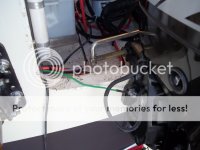thataway
Well-known member
- Joined
- Nov 2, 2003
- Messages
- 21,692
- Reaction score
- 63
- C Dory Year
- 2007
- C Dory Model
- 25 Cruiser
- Hull Identification Number
- DOR25652A707
- Vessel Name
- thataway
Tug, thanks for copying the drawing and posting it--it does clarify the rules. I was too pressed for time to find a way to copy it, without putting it in my album and then linking.
The only difference between the one well pictured by "tug" and those boats built after Jan. 1 2012, is the addition of a carbon filter on the vent line--which I suspect will cause all sorts of problems down the line.....
Fill hoses can be bent--but cannot have an "S" where fuel can hang up--and one has to be cautious about being able to fill the fuel tank at a reasonable rate.
As for ventilation under the tank--it is not a rule, but is related to corrosion. The best way is to 5200 strips of plastic to the bottom of the tank and then the strips to the bottom of the boat. Any straps or supports cannot have any carbon containing material (such as many "rubbers") which touch the tank surface, because of potential galvanic action on the tank at that point. Any water in the cockpit floor needs to be able to flow to a bilge pump and not stand under the tank--especially immerse the bottom of the tank.
The only difference between the one well pictured by "tug" and those boats built after Jan. 1 2012, is the addition of a carbon filter on the vent line--which I suspect will cause all sorts of problems down the line.....
Fill hoses can be bent--but cannot have an "S" where fuel can hang up--and one has to be cautious about being able to fill the fuel tank at a reasonable rate.
As for ventilation under the tank--it is not a rule, but is related to corrosion. The best way is to 5200 strips of plastic to the bottom of the tank and then the strips to the bottom of the boat. Any straps or supports cannot have any carbon containing material (such as many "rubbers") which touch the tank surface, because of potential galvanic action on the tank at that point. Any water in the cockpit floor needs to be able to flow to a bilge pump and not stand under the tank--especially immerse the bottom of the tank.









